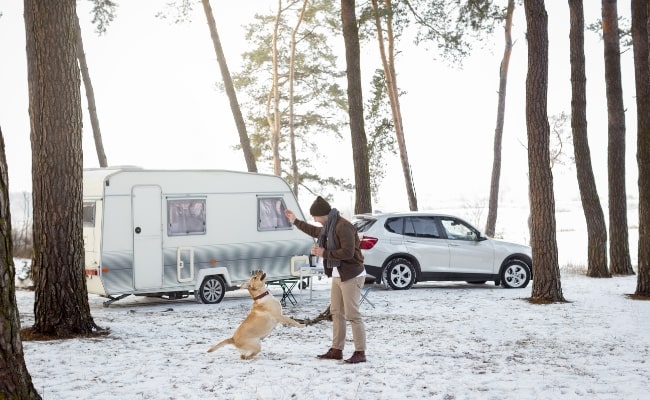Winterizing isn’t extra—it’s insurance. A couple gallons of RV/marine (non-toxic, pink) antifreeze, some basic steps, and RVs nap safely till spring. Winterizing is a process that involves a series of steps to protect your RV from winter damage and ensure it’s ready for use when warmer weather returns. Skip it and you’re playing freeze-pipe roulette, battery doom, and mold-town.
What “winterize” actually means
- Plumbing protection: Drain tanks/lines, bypass the water heater, and use RV/marine propylene glycol antifreeze in lines & traps (not automotive antifreeze—different chemistry).
Many RVers used to rely on repair shops for winterizing, but now more are doing it themselves.
- Moisture + mold control: Dry the interior, crack ventilation (with covers), and use moisture absorbers.
- Battery care: Charge, disconnect, and store correctly so it’s not toast in March.
- Appliance + fuel care: Stabilize fuel, prep the generator, defrost the fridge, and leave doors ajar—this is especially important for motorhome owners to protect engines and generators.
- Seal + tire care: Inspect/refresh seals, set tire pressure, and prevent flat spots. Trailer owners should pay special attention to these steps to protect their trailer from winter damage.
Always consult your owner's manual for model-specific winterizing steps and recommendations.
What happens if you skip it
- Burst lines & fittings → pricey plumbing surgery. When water freezes, it expands and can cause burst lines.
- Cracked faucets/valves → sneaky leaks in spring. Cracked valves can also lead to fluid leaks and loss.
- Dead batteries → replacement $$ and trip delays.
- Mold/mildew smells → deep clean + decon = no fun. Leaving water or waste in tanks for an extended period increases the risk of bacteria growth and freezing.
- Flat-spotted tires → vibrations and premature wear.
- Pests → free tenants, not cute.
When to winterize
- Do it before the first hard freeze (temps around 28°F/−2°C for several hours), as dropping temperature is the main trigger for winterizing to prevent damage.
- If nights flirt with freezing on the regular, don’t wait—winterize now and de-winterize later if you sneak in a warm-weather trip.
What you’ll need (quick kit)
- 2–4 gallons RV/marine antifreeze (propylene glycol, pink) — check the shelf life of antifreeze before use
- Water heater bypass (often installed from factory)
- Blow-out plug + air source with regulator (keep it gentle: ~30–40 PSI) (an air compressor can be used)
- Hose for draining or filling water tanks or pumps
- Basic tools, towels, bucket, funnel
- Moisture absorbers (e.g., calcium chloride or similar)
- Fuel stabilizer (for motorized units/generator)
- Silicone/compatible sealant for touch-ups (per your roof/wall material)
- Optional: tire blocks, breathable RV cover, vent covers, critter deterrents
- Note: Have tools available to access hard-to-reach components.
Maintenance and repair (pre-winter checkup)
Before you even think about pumping in antifreeze or draining tanks, give your RV a solid once-over. Start with the water heater—check the water heater tank and the water heater’s heating element for any signs of corrosion or leaks. If your anode rod looks like it’s been through a few too many winters, swap it out now. Next, inspect the water pump and all plumbing lines for cracks, leaks, or loose fittings. A quick fix now beats a major repair later.
Don’t forget the gray water tanks and black water tank—make sure they’re draining properly and that all drain plugs are tight and undamaged. Peek at the outdoor shower and toilet bowl for any wear or damage that could turn into a mid-winter headache. This is also the perfect time to check for any sneaky leaks around the plumbing lines or under sinks. Catching these issues before winterizing means you’re not sealing in problems that could get worse over the cold months. A little maintenance now keeps your RV’s tanks, lines, and toilet in top shape, so you’re not greeted by surprises when spring rolls around.
Step-by-step: the no-panic checklist
- Drain fresh water & heater
- Turn off water heater and let it cool. Open the pressure relief valve on the water heater unit before draining.
- Open low-point drains, low point drain plugs, and fresh tank drain. Make sure all water sources are fully shut off.
- Remove the water heater drain plug and/or anode rod to ensure the water heater and tanks are completely drained. Also, drain the holding tank.
- After draining, install the drain plug or anode rod securely.
- Bypass the hot water tank (never allow antifreeze to start filling the tank). Always bypass the water heater unit before filling the system with antifreeze to avoid wasting antifreeze and to simplify dewinterizing.
- Blow out the lines (optional but clutch)
- Attach blow-out plug at the city water inlet.
- Regulate air to ~30–40 PSI.
- Open each faucet (hot + cold faucets), showers (inside/outside), and toilet until only air mists out. Make sure you are blowing out each line and all water lines to remove all the water from the system.
- Pump in RV antifreezeUse the winterize siphon at the water pump or a hand pump on city inlet. Connect antifreeze to the inlet side of the water pump and use the pump to pump antifreeze through the system.
- Run pink through every fixture (hot + cold) until it flows solid pink, including all showers.
- Don’t forget: outside shower, washer hookups (if equipped), sprayer, and city inlet check valve.
- Pour 1–2 cups into each sink/shower P-trap and a cup into the toilet bowl to keep the seal happy.
- When de-winterizing, flush the system thoroughly with potable water to remove all traces of antifreeze.
- Tanks & valves
- After draining black/gray tanks, add a quart or two of pink to each to bathe valves/seals. Properly manage holding tanks during winterization to prevent freezing and damage.
Sanitizing and cleaning (before you close up)
Before you tuck your RV in for its winter nap, give the water system a deep clean. Start by draining the water heater tank and flushing out any lingering gunk with a cleaning wand or a gentle blast of compressed air. This helps clear out sediment and keeps your water heater and plumbing lines fresh for next season.
Next, pour a small amount of non-toxic RV antifreeze down every drain and into the toilet bowl—this protects your plumbing lines and traps from freezing temperatures. For a final touch, sanitize your tanks and plumbing lines with a square inch of bleach per the owner’s manual (always double check your manual for the right ratio and safety steps). This step keeps your system free from bacteria and funky smells, so when it’s time to de-winterize in spring, you’re ready to roll with clean, safe water.
By taking the time to sanitize and clean before winterizing, you’re not just protecting your RV from freezing—you’re making sure your water system is fresh, safe, and ready for adventure as soon as the temperatures climb.
Don't Want to Have to Do This? Let Us Do It For You!
De-winterizing (fast forward to spring)
- Reconnect/charge batteries, flush and ensure all lines are thoroughly flushed of pink, restore water heater to normal, sanitize the fresh system, check for leaks, and reset appliances. Quick systems check = stress-free first trip.
FAQs
Is blowing out the lines enough without antifreeze?
In mild climates, sometimes. For real cold snaps, do both: blow out + pink. It’s cheap insurance.
Can I use automotive antifreeze?
No. Use RV/marine (propylene glycol, non-toxic) antifreeze. Automotive (ethylene glycol) is toxic and not for potable systems.
How much antifreeze will I need?
Most trailers and motorhomes use 2–4 gallons; bigger coaches may need more. It depends on plumbing layout and whether you blow out lines first.
Do I put antifreeze in the water heater?
No. Bypass the hot water tank and drain it. Antifreeze belongs in lines and traps, not the heater tank.
Who should winterize their RV?
All RV owners should follow these steps to protect their plumbing systems from freeze damage.
Why bypass the water heater?
Bypassing prevents filling the hot water tank with antifreeze, which saves antifreeze and makes dewinterizing easier.
What if I’m storing in a “mild” climate?
If temps can hit freezing, winterize. One surprise cold night can still crack fittings.


